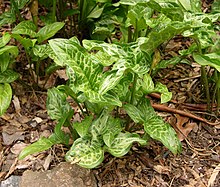Arum italicum
| Italian lords-and-ladies | |
|---|---|

| |
| Scientific classification | |
| Kingdom: | |
| (unranked): | |
| (unranked): | |
| Order: | |
| Family: | |
| Subfamily: | |
| Tribe: | Areae
|
| Genus: | |
| Species: | A. italicum
|
| Binomial name | |
| Arum italicum | |
| Synonyms[1] | |
| |
Arum italicum is a species of flowering herbaceous perennial plant in the family Araceae, also known as Italian arum and Italian lords-and-ladies.[2] It is native to the Mediterranean region (southern Europe, northern Africa, and the Middle East) plus Great Britain, the Netherlands, Crimea, Caucasus, Canary Islands, Madeira, and the Azores. It is also naturalized in Argentina and in scattered locations in the United States.[1][3][4][5][6][7]
It grows 1–1.5 feet (30–46 cm) high, with equal spread. It blooms in Spring with white flowers that turn to showy red fruit.[2] It is cultivated as an ornamental plant for traditional and woodland shade gardens.[2] Some gardeners use this arum to underplant with hosta, as they produce foliage sequentially; when the hosta withers away, the arum replaces it, leaving the ground covered.[8] Numerous cultivars have been developed for garden use, of which A. italicum subsp. italicum 'Marmoratum' has gained the Royal Horticultural Society's Award of Garden Merit.[9]
Arum italicum can be invasive in some areas.[8]
Arum italicum may hybridize with Arum maculatum.[10]
In 1778, Lamarck noticed that the inflorescence of this plant produces heat.[11]
Gallery
-
Berries
-
Leaves
-
Mature leaves
-
Mature leaf
References
- "Arum italicum". Integrated Taxonomic Information System. Retrieved September 25, 2006.
- ^ a b Kew World Checklist of Selected Plant Families
- ^ a b c MBG- hort. . accessed 11.1.2011
- ^ Altervista Flora Italiana, Pan di serpe, Large Cuckoo Pint, Italian Lords And Ladies, gouet d' Italie, flor de la primavera, jarro-dos-campos, Arum italicum Miller
- ^ Govaerts, R. & Frodin, D.G. (2002). World Checklist and Bibliography of Araceae (and Acoraceae): 1-560. The Board of Trustees of the Royal Botanic Gardens, Kew.
- ^ Castroviejo, S. & al. (eds.) (2008). Flora Iberica 18: 1-420. Real Jardín Botánico, CSIC, Madrid.
- ^ Dobignard, D. & Chatelain, C. (2010). Index synonymique de la flore d'Afrique du nord 1: 1-455. Éditions des conservatoire et jardin botaniques, Genève.
- ^ Biota of North America Program, 2013 county distribution map
- ^ a b Wisconsin Extension
- ^ "RHS Plant Selector - Arum italicum subsp. italicum 'Marmoratum'". Retrieved 2 June 2013.
- ^ Plantsman v13:3, p142, September 2014; Royal Horticultural Society
- ^ Meeuse, B.J.D. 1975. Films of liquid crystals as an aid in pollination studies. In Pollination and Dispersal, ed N.B.M. Brantjes, H.F. Linskens, pp 19-20. Nijmegen. The Netherlands: Dep. Botany, Univ. Nijmegen.




